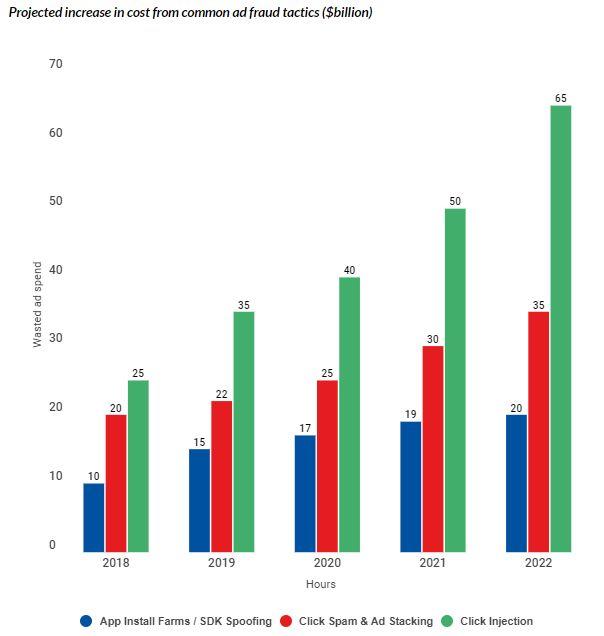Report: Ad fraud costs to surge 21% to $120bn

This story has been updated since publication. Please see details at the end of the article.
Ad fraud is forecast to cost US marketers $120bn this year – a 21% year-on year increase on 2021.
With digital advertising “no longer even close to optional” and ad fraud software becoming more sophisticated, marketers need to proceed with caution, according to a recent report by Business of Apps.
Common ad fraud tactics, such as app install farms, click spam, and click injection, are not only increasing, but increasing at sharper rates than they have in the past.

The forecast notes that over half of loss due to fraud is attributed to “click injection”, a fraud technique that aims to win the last-click attribution in cost per install campaigns on Android devices.
Meanwhile, the projected amount of ad spend lost thanks to app install farms/SDK spoofing has doubled since 2018. For click injection, the projected loss has increased by 160% during the same timeframe.
Year-over-year from 2021 to 2022, click spam and ad stacking contributed to a projected 16% increase in losses and click injection contributed to a projected 30% increase in losses.
To counter the rise in ad fraud, HubSpot has recommended leveraging targeting to cut down on the chance of click fraud. Other services such as AppsFlyer and Perform[cb] act as ad fraud prevention tools that have in the past uncovered and stopped ad fraud schemes.
The high and rising degree of ad fraud has come under added scrutiny in the past year. In March, USA Today publisher Gannett admitted it provided inaccurate information to advertisers for nine months without any of their clients taking notice. The debacle has raised questions about the effectiveness of programmatic advertising and its susceptibility to fraud.
Update: The Business of Apps report was originally published on the Association of National Advertisers (ANA) blog. Shortly after publishing this story on June 6, the ANA took down their blog post that described the ad fraud estimates. The post, which was originally published on May 26, was taken down because upon further review, the ANA discovered it referenced an old rather than a new report.
In a statement to The Media Leader, a spokesman for the ANA clarified:
“The item in question was an ANA blog post that referenced an ad fraud report that was totally unrelated to the ANA. It was NOT an ANA ad fraud report, as was interpreted by some readers. The blog post was then included in an ANA newsletter, which is where most people saw it.
“[W]e removed the blog post because upon close review we discovered that the numbers cited in the referenced report, although mentioned in the 2022 Forbes article, were actually findings from a 2019 report. We decided we did not want to include projections from four years ago because we felt they did not properly reflect the current situation regarding ad fraud. As a result, we decided to pull the blog post and newsletter item from our website.”
The Business of Apps post cites several different reports on ad fraud from the past few years, including among them the above estimates.



